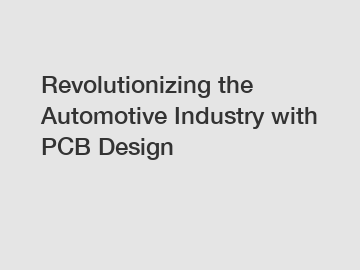Revolutionizing the Automotive Industry with PCB Design
Revolutionizing the Automotive Industry with PCB Design.
The automotive industry has always been at the forefront of technological advancements, constantly seeking ways to improve performance, efficiency, and safety. One key area that has undergone a significant revolution is the design and integration of printed circuit boards (PCBs) in vehicles. PCB design has played a crucial role in transforming the automotive industry, enabling manufacturers to produce vehicles that are more reliable, efficient, and intuitive than ever before.
The origins of this revolution can be traced back to the increasing complexity of automotive systems. With the emergence of electric vehicles (EVs), autonomous driving capabilities, and advanced driver-assistance systems (ADAS), the need for sophisticated PCBs has become paramount. These systems require highly integrated electronics to operate seamlessly, and traditional wiring harnesses have proven to be inadequate in managing the complexity and miniaturization demands.

PCBs have revolutionized the automotive industry by offering a more compact and efficient solution for interconnecting various electronic components. The design process starts with creating a layout that accommodates all the necessary circuits while optimizing space and reducing signal interference. With advancements in software and manufacturing techniques, designers can now integrate multiple layers, enabling a higher component density within a compact form factor.
Furthermore, PCB design enables better thermal management, critical to the success of modern automotive systems. EVs, in particular, generate significant heat due to high-power electronics, and effective thermal dissipation is essential for system longevity and performance. PCBs allow for the inclusion of heatsinks, thermal vias, and other cooling mechanisms, ensuring efficient heat dissipation and preventing overheating.
Another significant advantage of PCB design is the ability to incorporate advanced connectivity features. With the rise of connected vehicles and the Internet of Things (IoT), PCBs enable seamless integration of wireless communication modules, enabling real-time data exchange between vehicles, infrastructure, and other smart devices. This connectivity enhances safety, enables over-the-air software updates, and paves the way for future innovations in autonomous driving and intelligent transportation systems.
The impact of revolutionizing the automotive industry with PCB design goes beyond technology. It has opened up avenues for greater collaboration in the industry, bringing together semiconductor manufacturers, PCB designers, automotive engineers, and software developers to work towards a common goal. This cross-disciplinary approach has accelerated innovation, enhanced the quality of vehicles, and fostered a more rapid time-to-market for new technologies.
In conclusion, the automotive industry has been revolutionized by PCB design. From the origins of addressing complexity to the advancements in thermal management and connectivity, PCBs have played a pivotal role in improving the performance, efficiency, and safety of vehicles. This revolution has not only transformed the way vehicles are built but has also fostered collaboration and innovation, shaping the future of the automotive industry.
If you are looking for more details, kindly visit consumer electronics pcb , security product pcb board , automotive pcb design .
234
0
0

Comments
All Comments (0)